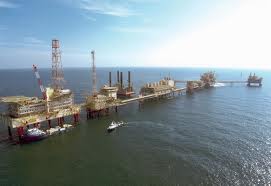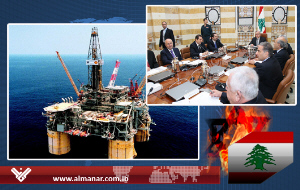A three-episode investigation on the story of oil and gas resources in Lebanon and neighbors.
It is the ‘Oil for Oil’ formula set by Hezbollah Secretary General Sayyed Hasan Nasrallah; yet, the story of oil wells and black gold in the Indebted State goes back to the last century ...
OIL EMERGENCE IN LEBANON
 Oil excavation in Lebanon started during the stage of ‘Oil Fever’, which touched Arabian Peninsula in the late thirties. Between forties and mid fifties, seven deep wells dug in Lebanon gave hint for some oil evidence, even though it wasn’t worthy. The wells were dug in the regions of Qa’a (east Lebanon), Tal-Zanoub (Mount Lebanon), Sohmor, Yohmor, Adloun (South Lebanon), Abreen and Terbel (North Lebanon).
Oil excavation in Lebanon started during the stage of ‘Oil Fever’, which touched Arabian Peninsula in the late thirties. Between forties and mid fifties, seven deep wells dug in Lebanon gave hint for some oil evidence, even though it wasn’t worthy. The wells were dug in the regions of Qa’a (east Lebanon), Tal-Zanoub (Mount Lebanon), Sohmor, Yohmor, Adloun (South Lebanon), Abreen and Terbel (North Lebanon).
During the French mandate in Lebanon, French authorities decided to conduct a geological survey in the area they controlled (Lebanon, Syria and part of Southern Turkey). The French geological engineer Louis Depatrie was assigned for this task, and he was able to finalize the geological map of Lebanon within 25 years.
Since that date, geologists continue to study the different Lebanese aspects of geology, where researchers published new works that contributed to the enrichment of geological library with more information. Later on, scientific studies and researches went on despite the ignorance of foreign scientific companies and institutions.
Those researches could shed light upon some oil exploration processes, which revealed that the Lebanese land, because of its fold types, had the possibility of containing oil in areas different from the discovered ones.
 As a result of another study covering Lebanon and Syria, the presence of Mother Rocks inside the deep Sedimentary Rocks became possible, just like the matter of ‘Bearing Rocks’ which also have the possibility of containing oil.
As a result of another study covering Lebanon and Syria, the presence of Mother Rocks inside the deep Sedimentary Rocks became possible, just like the matter of ‘Bearing Rocks’ which also have the possibility of containing oil.
OIL EXPLORATION IN SEA
First attempt to explore oil in sea was in the early nineties, and was based upon scores of studies carried out by the late Lebanese geologist Ziad Baidoun. The northern area, which extends from the city of Tripoli (south) till the Lebanese border with Syria (north), was assigned for the project. Baidoun determined indexes which pointed at the presence of oil at 3 km under the sea level, and 6 km under the Bekaa Valley.
On this point, the geologist Ata Elias told Al-Manar that Baidoun had carried out a geophysical survey off the Lebanese northern shore to study ground layers beneath the sea surface. He focused in his research on the regions of ‘Rabbits’ Islands’ and ‘Palms’ Islands’ off Tripoli (north Lebanon); however, they were not the sole places in which oil may be contained. Dr. Baidoun – with the cooperation of foreign geophysical companies – had made the survey in sea.
In nineties, the Lebanese government used a geophysical studies company to carry out the seismic survey for the assigned area. The survey proved the presence of structures valid to contain oil.
With the governments’ succession in the nineties, all attempts to found those reports were in vain. Researchers hadn’t any capability to continue the research, even after contacting the company which was assigned for it, and which declared that it didn’t have the mentioned data.
 In 2000, a company made a coastal survey outside the territorial borders. The outcomes of that work were the reason for carrying out the seismic survey in the northern region one more time.
In 2000, a company made a coastal survey outside the territorial borders. The outcomes of that work were the reason for carrying out the seismic survey in the northern region one more time.
However, despite the frequent information and studies which affirm the oil fortune in Lebanon, Lebanese government took no step towards such project till 2002. During that year, Lebanon entered into a contract with the British company ‘Spectrum’ that made a two-dimension survey over the whole Lebanese shore. Survey lines covered about 20 thousand kilometers east the Mediterranean. Some of these lines were along the beach, while the others were vertical. The survey reached a distance of 160 km inside the sea depth between Lebanon and Cyprus.
Geological researches didn’t stop then. ‘BGS Company’ made three-dimension surveys between the years 2006 and 2007 inside the Lebanese and the Lebanon-Cyprus waters. The company noted that commercial quantities of oil in Lebanon might be up to 50%, and Lebanon might have oil stocks that reach 8 billion barrels.
Due to the increasing indexes of oil fortune in Lebanon in land and sea, the Zionist entity carried out oil explorations in the territorial water of the Occupied Palestine.
“In 2005, Israel announced oil fields in the economic area of the occupied Palestine, off the shore of Acre and in the northern region,” retired brigadier general Dr. Amin Hoteit said in this regard.
And the crisis here began.
To be continued …
To read this part in Arabic, click here.
In Part II: Israeli Greed & Agreement with Cyprus.
